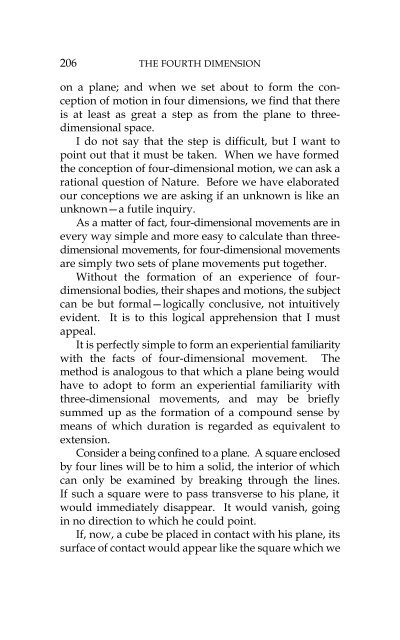Create successful ePaper yourself
Turn your PDF publications into a flip-book with our unique Google optimized e-Paper software.
206<br />
THE FOURTH DIMENSION<br />
on a plane; and when we set about to form the conception<br />
of motion in four dimensions, we find that there<br />
is at least as great a step as from the plane to threedimensional<br />
space.<br />
I do not say that the step is difficult, but I want to<br />
point out that it must be taken. When we have formed<br />
the conception of four-dimensional motion, we can ask a<br />
rational question of Nature. Before we have elaborated<br />
our conceptions we are asking if an unknown is like an<br />
unknown—a futile inquiry.<br />
As a matter of fact, four-dimensional movements are in<br />
every way simple and more easy to calculate than threedimensional<br />
movements, for four-dimensional movements<br />
are simply two sets of plane movements put together.<br />
Without the formation of an experience of fourdimensional<br />
bodies, their shapes and motions, the subject<br />
can be but formal—logically conclusive, not intuitively<br />
evident. It is to this logical apprehension that I must<br />
appeal.<br />
It is perfectly simple to form an experiential familiarity<br />
with the facts of four-dimensional movement. <strong>The</strong><br />
method is analogous to that which a plane being would<br />
have to adopt to form an experiential familiarity with<br />
three-dimensional movements, and may be briefly<br />
summed up as the formation of a compound sense by<br />
means of which duration is regarded as equivalent to<br />
extension.<br />
Consider a being confined to a plane. A square enclosed<br />
by four lines will be to him a solid, the interior of which<br />
can only be examined by breaking through the lines.<br />
If such a square were to pass transverse to his plane, it<br />
would immediately disappear. It would vanish, going<br />
in no direction to which he could point.<br />
If, now, a cube be placed in contact with his plane, its<br />
surface of contact would appear like the square which we






![[PDF] Prolegomena](https://img.yumpu.com/16774951/1/190x245/pdf-prolegomena.jpg?quality=85)









